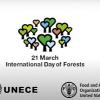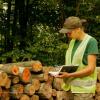Forestry Press Releases
Displaying Results 26 - 50 of 126
For most of early history, humans obtained their food by hunting and collecting wild plants in grasslands and forests. Nowadays, the conversion of forest land to land for agriculture is the single largest driver of deforestation worldwide, contributing to climate change and biodiversity loss on an
Recent trends suggest that the forest sector workforce across the UNECE region is facing considerable challenges. These include an ageing workforce, underrepresentation of women and minorities, as well as declining job opportunities as a result of increased mechanization, reorganization of forestry
In light of unprecedented heatwaves and series of lockdowns that hit cities across Europe and North America over the last year, ensuring there are green urban spaces that could help bring down the temperature and provide safe spaces for recreation and relaxation has never been higher on policy-
Wood energy has been the leading source of renewable energy in the UNECE region for more than a decade, accounting for 35.4% of renewable energy supply for 31 countries, according to the latest results from the UNECE/FAO Joint Wood Energy Enquiry (JWEE). For Austria, Cyprus, Finland, France,
As governments worldwide impose lockdowns in an attempt to halt the spread of the coronavirus, many industries are expected to suffer the consequences. The forest sector is no exception, and this comes after couple of particularly tough years marked by a rise in pest infestations, wildfires and
According to a new study published by the UNECE and FAO, altogether almost 4.3 million people work across the forest sector of North America, Europe and Central Asia; predominantly in Europe (51 percent), the United States and Canada (29 percent), the Russian Federation (14 percent) and Turkey (5
In the eight countries of the Caucasus and Central Asia, 28.8 million hectares of existing forests and other wooded land are particularly vulnerable to climate change, biodiversity loss and degradation of ecosystems. To address these challenges, these countries have made considerable efforts to
According to a new study published by the UNECE and FAO, altogether almost 4.3 million people work across the forest sector of North America, Europe and Central Asia; predominantly in Europe (51 percent), the United States and Canada (29 percent), the Russian Federation (14 percent) and Turkey (
The forests of the Caucasus and Central Asia (Armenia, Azerbaijan, Georgia, Kazakhstan, Kyrgyzstan, Tajikistan, Turkmenistan, and Uzbekistan) rarely make international headlines and are often overlooked in global debates on forest preservation and sustainable management. Nevertheless, these forests
The world has lost around 420 million hectares of forest to other land uses since 1990, with an annual rate of deforestation estimated at 10 million hectares over the last five years, the Food and Agriculture Organization of the United Nations (FAO) said in its 2020 Global Forest Resources
As governments worldwide declared lockdowns in an attempt to contain the spread of COVID-19, animals and plants started reclaiming spaces previously seen as being reserved for human activities: fish, ducks and dolphins inhabited canals and approached shores, while deer, wild goats and monkeys
All over the world, mayors and local authorities are taking climate action through tree-planting in and around cities. The benefits of urban forests are plentiful: aside from filtering air pollutants, a single tree can absorb up to 150kg of CO2 per year, help regulate urban temperatures, reduce
The boreal forest that circles the globe doesn’t make it to the news as often as the Amazon rainforest. However, it contains a third of all the trees on earth and in combination with its soil forms the largest storage of CO2, while refreshing the entire planet’s atmosphere with the oxygen it
Storms, beetle infestations, and wildfires: when reading the news about forests in the past months, it is evident that it has been a tough year for the forest sector. It is estimated that in Europe approximately 25% of the 2018 timber harvest was damaged by either storms or insects and in North
Caused by human activity and bio-physical factors, the degradation of land and ecosystems, exacerbated by climate change, is one of the greatest challenges facing Europe, the Caucasus and Central Asia.Desertification affects 8% of the territory of the European Union, including around 14 million
Azerbaijan brings degraded land restoration commitments in Caucasus and Central Asia to 3 million ha
Azerbaijan has announced it will restore 170,000 ha of degraded lands by 2030, and an additional 100,000 ha conditional upon receiving funding, under the Bonn Challenge. The Bonn Challenge is a global effort to bring 350 million ha of degraded and deforested land into restoration by 2030.
Many communities around the world rely heavily on healthy forests for the social, economic and environmental benefits they bring. But without the required skills and capacities to monitor and measure the status of forests, they cannot guarantee the sustainable management of these precious
The forests of the Caucasus and Central Asia are vital in fighting erosion and desertification in the harsh climates of the region. They host a rich biodiversity and provide livelihoods for the rural population, who have few other sources of revenue. These forests also serve as important sources
Forests are life in its essence. Through education and training we can help safeguard these important and highly diverse ecosystems, providing clean air and water, while supplying food, wood and shelter. Today, the global community celebrates the International Day of Forests (IDF) 2019 under the
Forests cover 42 percent of the UNECE region, which embraces countries of North America, Europe, the Caucasus and Central Asia. Forests are not only the dominant type of land cover but also a critical element for ecosystem maintenance and sustainability. While studies and reports on the region’s
The 24th Conference of the Parties to the UN Framework Convention on Climate Change (COP24), taking place in Katowice, Poland, from 2 to 14 December 2018, is discussing global action to reduce emissions and keep global warming within the temperature limits of the Paris Agreement. While
Forests are rare in the Caucasus and Central Asia, and, as any rare good, should be valued, protected and cared for. This is because as of today still little is known about their values and state. To enhance the knowledge of forests in this
Innovative and sustainably produced wood products, when coupled with sustainable forest management, can ‘build the future’ and contribute to the achievement of the Sustainable Development Goals (SDGs). In a sector like construction, which globally accounts for 6% of total energy consumption
Spruce, pine and fir are the main families of coniferous trees fueling the global forest products sector. They provide the raw material for just under 60% of wood products in the world. Products derived from these species are used as construction materials for buildings, for paper and paper
Given the many threats to global water supply, forest management and planning will increasingly need to deploy strategies for optimizing watershed services – such as water purification, the regulation of surface flows, and erosion control. The services provided by forest ecosystems for water








